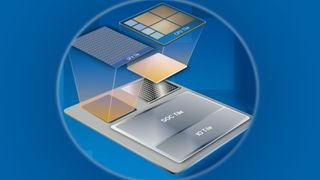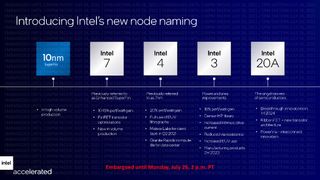Intel Rumored to Pull-in 2nm Arrow Lake-S Launch to H1 2024
Some details about Intel's 2024 plans for desktops leak.

Intel has canceled its codenamed Meteor Lake-S processor for desktops and is set to pull in the introduction of Arrow Lake-S to the first half of 2024, according to a new rumor published by BenchLife. However, some market observers believe the rumor is incorrect, and Intel's Meteor Lake-S is on track to hit desktops in the first half of 2024.
Curious Desktop Roadmap
Intel has been discussing the advantage of its disaggregated Meteor Lake processor for mobile computers for a couple of years and is expected to launch notebook versions of these CPUs in 2023. But instead of releasing Meteor Lake-S processors along with its 800-series chipsets in 2H 2023 or 1H 2024, the company intends to introduce codenamed Arrow Lake-S CPUs compatible with the same platform controller hub (PCH) family (Intel Z890, W880, Q870, B860, and H810) in the first half of next year, BenchLife suggests.
Since the information comes from an unofficial source, it should be taken with a grain of salt. However, there might be a rationale behind the rumor. Intel's desktop and workstation roadmap leaked late last year, indicating that the company plans to introduce Raptor Lake-S Refresh for client PCs in Q3 2023. The Meteor Lake-S platform was not set to be released in 2023.
Intel's Meteor Lake and Arrow Lake processors are the company's first CPUs for client PCs that use disaggregated multi-tile designs. Intel's Meteor Lake's compute tile is set to be produced on Intel 4 node (previously known as Intel 7nm, the company's first technology to use extreme ultraviolet lithography). In contrast, Arrow Lake's compute tile is set to be made using the company's Intel 20A (2nm-class) fabrication process. In addition, the CPUs are expected to feature a graphics tile produced by TSMC on its N3E manufacturing technology.

Meteor Lake-S and Arrow Lake-S processors are expected to use Intel's LGA1800 socket (also referred to as LGA1851 sometimes) and 800-series chipsets. In theory, Intel could substitute the former with the latter, but that may not be possible. While Intel's 20A node is set to be production ready in the first half of 2024, this does not mean that Intel will be prepared to support a high-volume 20A-based product launch in the first half of next year.
This is perhaps why hardware spotter @SquashBionic does not believe Intel can pull in Arrow Lake to 1H 2024. Instead, the blogger implies that Meteor Lake-S is still on track for 1H 2024.
So far, Intel has not disclosed anything about configurations of Meteor Lake's and Arrow Lake's compute tiles. However, BenchLife asserts that Arrow Lake-S processor's compute tile will comprise eight high-performance cores and 16 energy-efficiency cores, which aligns with the number of general-purpose cores Raptor Lake has. Meanwhile, 6P+16E Meteor Lake will never be released for desktop, BenchLife asserts. Meanwhile, Intel has never offered 6P+nE configurations for socketed desktops whatsoever. As for memory support, both Meteor Lake and Arrow Lake processors are expected to support DDR5-6400 memory, improving their performance considerably.
Stay on the Cutting Edge
Join the experts who read Tom's Hardware for the inside track on enthusiast PC tech news — and have for over 25 years. We'll send breaking news and in-depth reviews of CPUs, GPUs, AI, maker hardware and more straight to your inbox.
Rushing 20A-Based Product?
Producing 24-core silicon on Intel 4 and Intel 20A node should be more beneficial from a costs perspective than making a highly integrated monolithic 24-core Raptor Lake-S CPU on Intel 7 process technology (formerly called 10nm Enhanced SuperFin), assuming that yields are similar. Therefore, Intel should be very inclined to introduce both Meteor Lake processors sooner rather than later.

However, rushing 20A-based Arrow Lake CPUs to the market may not be the best idea. Intel's 20A is a rather revolutionary node as it is set to introduce the company's RibbonFET gate-all-around transistors with PowerVia backside power delivery. Usually, the company begins to roll out new nodes with desktop parts, but it is not used to pull in CPUs made on a brand-new node to market by at least half a year.
While it would be good to see Intel's Arrow Lake-S on the market ahead of schedule, there are way too many things that do not add up with the report. Therefore, consider the information about Arrow Lake-S in H1 2024 as a rumor that has a high probability of being false.

Anton Shilov is a Freelance News Writer at Tom’s Hardware US. Over the past couple of decades, he has covered everything from CPUs and GPUs to supercomputers and from modern process technologies and latest fab tools to high-tech industry trends.
-
MBOO7 They dont seem to learn from their old mistakes...Reply
Still wanting to put too much into one product all at once, causing high dependencies on multiple levels...
If one level fails the entire product goes through purgatory, waiting for a final release (only getting delayed and delayed). -
zecoeco More of the same.Reply
In my opinion, the only rumors that are hard to believe is Intel being ahead of schedule. -
cyrusfox Reply
🤣 Too truezecoeco said:In my opinion, the only rumors that are hard to believe is Intel being ahead of schedule.
With the move to dissaggregation though, should be faster to iterate (Keep same IO & GPU and change out CPU part).
As Meteor Lake is the first iteration, still premature speculation that Intel can execute.
I don't see how Raptor lake Refresh can compete if Meteor Lake Desktop is shelved. Reminds me of Comet to Rocket lake, they pushed out new CPU that was no better than prior gen... I don't get doing a Raptor Lake refresh, makes more sense to me to just release i5 meteor lakes, especially if it can best the 7800X3D. -
JamesJones44 The timing doesn't seem right. It's rare you start production on a node and start shipping volume on that node all at the same time. Maybe Intel 4 is way way ahead and volume ramp would not be at the same time as the product launch, but just based on timing I think odds seem to favor a rumor for clicks.Reply -
Arbie I'm trying to recall when I last believed or cared about an Intel report. I think it was around 2017.Reply -
ikjadoon Why is Intel not giving any concrete news about this year's node, Intel 4?Reply
A lot of "silence on 2023, shiny new thing in 2024" statements from Intel.
Intel 4 is apparently manufacturing ready, so it should have a lot more concrete news to share by now. CPU launches, sure, you're focused on Raptor Lake sales.
But the node? Jeez, Intel, the whole tech world is basically waiting for the "under-performing" or "delayed launch" or "slower ramp" report from IFS. -
Howardohyea I thought 20A isn’t even taped out yet and would only be production ready in H1 23, if that’s the case then the soonest product we can see using 20A is probably in H2 23 or even 24Reply -
SiliconFly ReplyHowardohyea said:I thought 20A isn’t even taped out yet and would only be production ready in H1 23, if that’s the case then the soonest product we can see using 20A is probably in H2 23 or even 24
The article states it's based on a unverified leak/rumor. 20A test chips already taped out. But thats just proof of concept. ARL cpu tile hasn't taped in yet in 20A (probably within 3 to 6 months). We can expect ARL tape out only after that.
20A volume ramp in 1H 2024 is unlikely. Q4 2024 is more likely (but that too is a hard bet). -
SiliconFly Replyikjadoon said:Why is Intel not giving any concrete news about this year's node, Intel 4?
A lot of "silence on 2023, shiny new thing in 2024" statements from Intel.
Intel 4 is apparently manufacturing ready, so it should have a lot more concrete news to share by now. CPU launches, sure, you're focused on Raptor Lake sales.
But the node? Jeez, Intel, the whole tech world is basically waiting for the "under-performing" or "delayed launch" or "slower ramp" report from IFS.
Ya it's kinda strange that there isn't much news/leaks about Intel 4 & meteor lake at this point considering it's in the later stages of the cycle. It's very unlike Intel.
Either something has changed abt how they do things there (unlikely). Or the state of affairs for MTL/Intel 4 is actually worse than thought. Already there are way too many rumors and/or predictions about MTL clock-speed regression due to Intel 4.
At this point, MTL might match RPL. Or might DOA. No one knows. Got to wait for some concrete info. -
bit_user Reply
I think that's more of a side-benefit. The main benefit should be their ability to use better cost/perf-optimized nodes for each tile.cyrusfox said:With the move to dissaggregation though, should be faster to iterate (Keep same IO & GPU and change out CPU part).
Compete against what? I thought AMD isn't slated to launch Zen 5 until 2024. Raptor Lake already holds its own against (non-3D) desktop Zen 4 products.cyrusfox said:I don't see how Raptor lake Refresh can compete if Meteor Lake Desktop is shelved.
It probably won't move the needle much vs. Ryzen 7000X3D, unless they're doing it to add their own 3D stacked cache.
🤯
That's a lot to unpack.cyrusfox said:Reminds me of Comet to Rocket lake, they pushed out new CPU that was no better than prior gen... I don't get doing a Raptor Lake refresh, makes more sense to me to just release i5 meteor lakes, especially if it can best the 7800X3D.
Rocket Lake did advance lightly-threaded workloads - especially those benefiting from AVX-512.
Rocket Lake brought Xe-LP to the desktop, which was a pretty big step up from Gen 9.5 HD graphics. More of a footnote, but worth mentioning.
Haswell Refresh was pretty successful (i.e. i7-4790K), though maybe CPUs like the i9-13900KS already reaped most of the gains left to be squeezed out of Raptor Lake.
The refresh could include some architectural tweaks that address various bottlenecks, such as L3 cache.
Even an i5 Meteor Lake might not be viable on the desktop, if they're facing issues like Intel had with Ice Lake - where it couldn't clock high enough to beat prior-generation desktop CPUs with the same core-count. It was still viable for low-power laptops, which is the market Meteor Lake is set to pursue.
Most Popular


